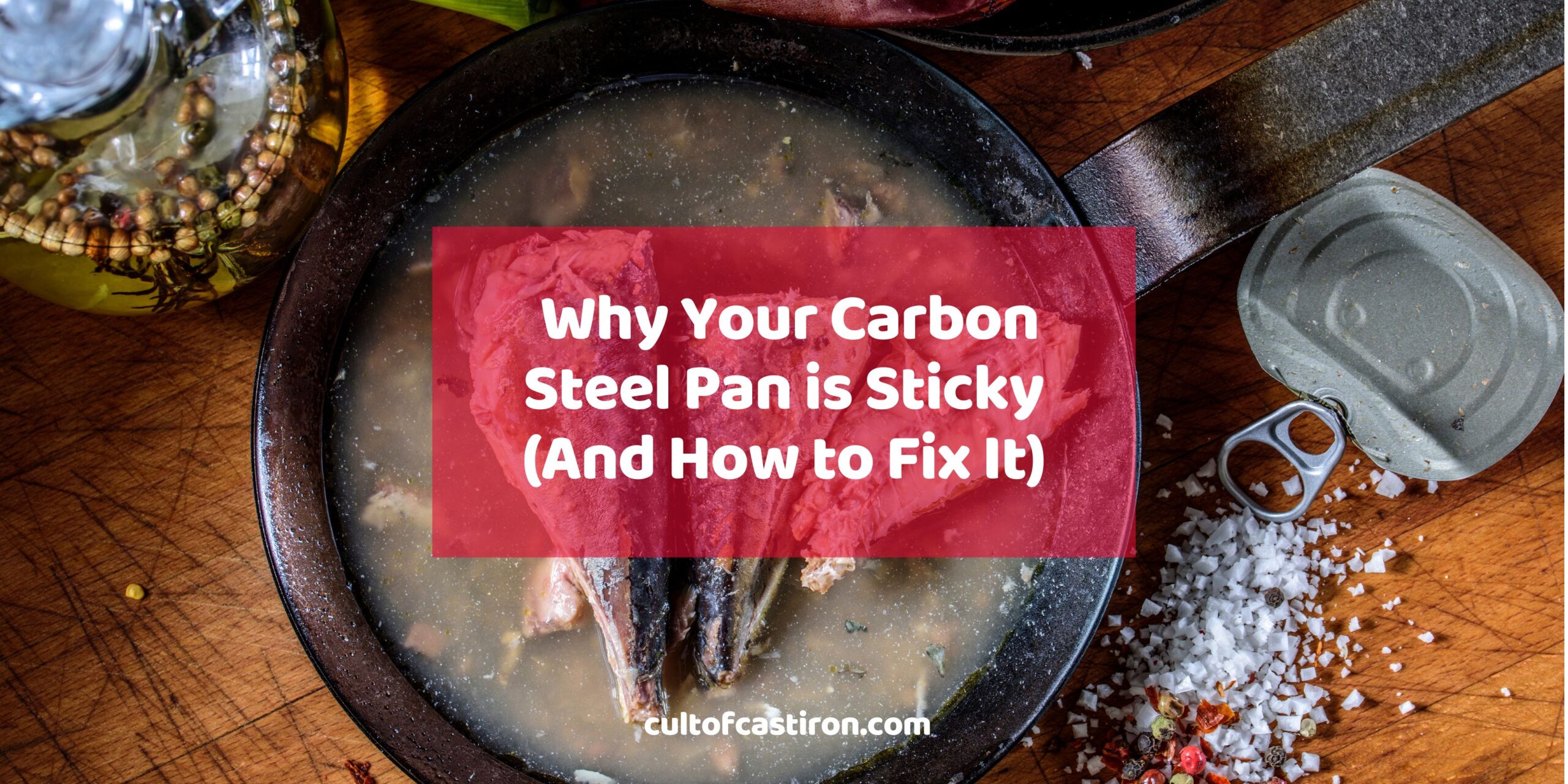Just like cast iron cookware, carbon steel pans are prized for their all-natural, non-stick seasoning that can make slidey eggs with ease. However, that level of performance only comes with proper care and seasoning. And while seasoning a carbon steel pan is actually easier than most people make it out to be, messing it up can leave you with a pan that is quite sticky to the touch.
The stickiness on your carbon steel pan is mainly due to the oil not polymerizing as it should. Now, this can be the result of many kinds of missteps, but whatever is the case, this predicament can be easily reversed in a few simple steps.
Keep reading as we take a more in-depth look at why your cast iron pans get sticky, simple ways to remove gummy residue, and how to prevent your carbon steel pan from becoming sticky in the future.
Common Reasons Why Seasoned Carbon Steel Pans Become Sticky
There are many reasons why your carbon steel pan developed a sticky surface – most of which are rooted in the way you’ve seasoned it. Try to retrace your steps to identify which of these reasons are the root cause of your problem.
Putting Too Much Oil
When it comes to seasoning a carbon steel pan, you only need the thinnest slivers of oil to polymerize and adhere to the pan. From there you can (and should!) add more thin layers of seasoning to improve the non-stickiness of your pan.
You cannot season a carbon steel pan in one go with an excessive amount of oil. What would likely happen is that only a hair-thin layer of oil will actually adhere to the pan, while the top portion of the oil will turn into a sticky blackish-brown residue that is halfway from being polymerized.
Using Saturated Fats
The kind of oil you’re using also plays a role in the stickiness of your seasoning.
Cooking oils can be categorized into two broad categories: saturated fats and unsaturated fats Of these two, unsaturated fats (canola, flaxseed, grapeseed) are the better type of oil for use in seasoning your carbon steel pans as they are more reactive, which means that they can form the polymerized chains necessary to produce a great layer of seasoning. While saturated fats (butter,. lard, coconut oil) can still be used for seasoning, unsaturated fats just do the job better.
Setting the Temperature Too Low
For oil to polymerize and bond to the pan’s surface, it must reach a certain temperature. Setting the oven or stovetop too low doesn’t allow the oil to fully break down and polymerize, leading to a sticky texture. It’s essential that you know set the temperature at or a little bit above the smoke point of your chosen seasoning oil for proper polymerization to take place.
Failing to Heat the Pan for a Sufficient Time
Completing the polymerization process requires not just the right temperature but also sufficient time. Rushing this process by not heating the pan long enough prevents the formation of a hard, durable coating. Typically, a pan should be heated for at least an hour to ensure the oil has fully polymerized, creating a robust layer of seasoning.
How to Fix a Sticky Carbon Steel Pan
While a sticky carbon steel pan is indeed annoying, it can be reversed in a few simple steps. Here’s how:
1. Scrub the Residue Off
Scrubbing the rest of the sticky residue off the pan should be easy enough, as it has not yet adhered to the pan. Begin by washing the pan with warm, soapy water and a non-abrasive scrubber. For stubborn stickiness, a paste made from kosher salt and water (or baking soda and water) can act as a gentle yet effective abrasive. Apply the paste to the sticky areas and scrub in a circular motion. This method helps lift the sticky residue without damaging the pan’s surface. Once the residue is removed, rinse the pan thoroughly with warm water.
2. Dry the Pan Thoroughly
After washing, it’s imperative to dry the pan completely to prevent rust. Wipe it down with a clean towel and then place it on a stovetop over low heat for a few minutes. This step ensures that all moisture is evaporated from the surface and the pan’s pores, prepping it for re-seasoning. Pay close attention to drying the pan as any remaining moisture can lead to rust formation, undermining your seasoning efforts.
3. Apply a Thin Layer of Oil to the Pan
With the pan clean and dry, it’s time to re-season. Choose an oil with a high smoke point and low saturation, such as flaxseed, canola, or grapeseed oil. Apply a very thin, even layer across the entire surface of the pan, including the sides and bottom. Use a paper towel to wipe off any excess oil, ensuring only a barely visible sheen remains. At this point, I will consider the problem fixed, especially if the previous layer of seasoning is intact. But if you want to turn this into a proper layer of seasoning, then you should heat the pan according to the oil’s smoke point for one hour (or until the oil looks dry). After heating, let the pan cool in the oven to room temperature. Remember to coat the pan in a thin layer of oil during storage to prevent rusting.
How to Prevent Your Carbon Steel Pan from Becoming Sticky
Preventing your carbon steel pan from becoming sticky only takes a few easy tweaks in your seasoning process. Here’s how:
Remove excess oil
After putting a small dollop of oil on the pan, even it out on the surface by wiping it with a paper towel (or any kind of towel for that matter.) As I’ve said earlier, you only need the tiniest sliver of oil for proper polymerization to take place. So make sure to remove as much oil as you can from the surface. Don’t worry about seemingly taking off too much oil – chances are, what’s needed is already on the surface, so don’t be too shy when wiping the pan.
Place the pan face side down
When seasoning your carbon steel pan in the oven, always place it face side down. This positioning allows any excess oil to drip away from the pan, preventing pooling and the subsequent sticky residue it can create. Additionally, placing a foil-lined baking sheet below the pan can catch any drips, keeping your oven clean.
Choose your oil wisely
The type of oil you use for seasoning matters significantly. Oils with a high smoke point and low saturation, such as flaxseed, grapeseed, or canola oil, are ideal. Personally, I use canola to season my cast iron and carbon steel cookware just because it is cheap and easily available.
Ensure that the polymerization process has been completed
The best way to check if the seasoning process is done correctly is by inspecting the pan closely.
If the oil looks dry, it means that you’ve seasoned the pan correctly. If the oil still looks – well, oily – it needs a little bit more time (or heat) to polymerize.
My “hold your breath” moment after seasoning is the wipe test. Basically, once I wipe the finishing coat of oil on the pan, I look closely at my paper towel. If the towel leaves colorless streaks of oil, then it means I’ve done it correctly. But if the towel has any sort of coloration of it (black or blackish brown) then it means that I’ve done something wrong, and I should put it back in the oven or start with the whole process again.
Conclusion
While fixing a sticky carbon steel pan is not a hard endeavor, I think we can all agree that prevention is better than cure.
If you’re still hungry for more information on everything about carbon steel cast iron cookware, then be sure to check out the rest of my blog!

Miguel is a cast iron enthusiast from Cavite, Philippines. He works in the digital marketing field as a content marketing strategist. On the side, he manages a small online bookstore and tends to his plants.

